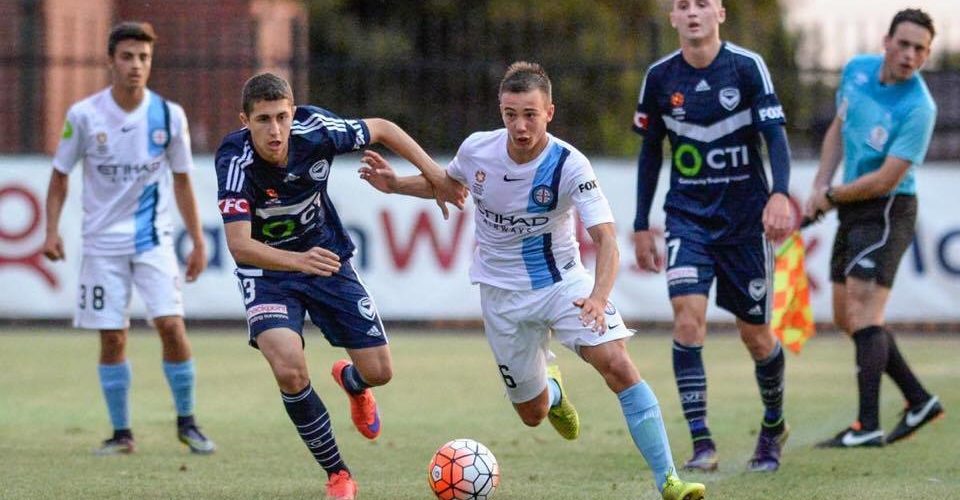Image: Mark Avellino
To the parents, coaches, and footballers who have young children aged from 3-7, and have a passion for the game, this is for you. This article is designed to educate teachers of the game about the little tricks of the trade you can implement to fast-track the development of a young footballer (or athlete) years before they even start playing sport.
Don’t be mistaken by a child’s appearance and innocence, internally their brain has the capability to learn extraordinary feats at a young age, similar to how Mozart became a technician of composing music before he was 10 due to his accumulation of over 10,000 hours of practice at a very young age.
At this stage of growth, there are certain areas of the brain and nervous system that are crucial to motor development and learnt behaviour of undertaking movements related to sport. We need to move away from the old-school teachings of juggling to reach 1000 kick-ups, or kicking a ball against the wall to improve your footballing ability.
Nueroplasticity of the brain is an amazing mechanism in which our experiences can create and build neural pathways within the brain, and build new neural connections to benefit our growth. Think of the way we learnt to walk, we slide on our stomachs, then shuffle forward on our bottom, then we crawl, sit, stand-up, stumble, wobble, finally accomplishing a normal walking motion. This is the process of motor learning and neural development, where we refine a skill until it is mastered becoming autonomic.
It becomes a skill we no longer need to apply a lot of concentration to execute, but rather requires no effort whatsoever. I want to recommend two powerful techniques which will develop their nueroplasticity and brain development to greatly improve in sport from a young age.
- Introduce them to challenging ‘games’
At around 12 months, most infants have learnt to walk, and it is at this point that the moulding of an athlete begins.
Regardless of what sport you hope for them to pursue, the more they are exposed to different environments requiring movements and stimulus that mimic sporting movements, the greater chance they have of learning complex skills later in life. Our highly functioning brain is forever on a lifetime journey to learn new movement patterns to be ingrained into our memory bank of learnt skills, similarly like the way we pick and choose products from a supermarket shelf at our own pleasure.
The key thing to remember here is the quicker you learn to master skills and pick them from our shelf (brain), compared to other children their age, the greater your chances of advancing in sport. When we choose to execute a skill, your brain will revel into its memory bank of learnt movements (like a savings account) and use it to the best of its ability (what you have learnt previously).
Just like the average footballer has an ingrained technique to take a free-kick, Messi has a much more complicated and finely tuned free-kick due to stronger neural pathways, coordination and accuracy, polished over many years and thousands of hours of practice with the correct guidance and coaching.
My advice is to expose your child to as many games, sports, and activities as you can before the age of nine, make it fun and enjoyable (rather than a chore, which will result in no enjoyment or motivation to play), and be mindful that the more skills they learn e.g. throwing/kicking a ball, playing with a balloon, running, reaching for objects, balancing on toys etc, the more these motor patterns will become refined in their ‘memory bank of skills’, and can slowly be refined into smooth and accurate skills, which become transferable across all sports.
From a physiological perspective, this exposure of executing skills requires coordination, proprioception, fine motor patterns, decision making, spatial awareness, compound movements, balance, etc., which overtime will empower these children to learn a sport at a quicker rate and at an earlier period of their life.
We perceive extraordinary talent as a genetically gifted child rather than a highly functioning athlete who has accumulated thousands of hours of practice. A perfect example of this is Messi, Ronaldo, and Ronaldinho, who began kicking a ball in their villages from an age where most children are playing with toy cars, and, although this was simply for the fun of it, these experiences and exposure to free play and games creates strong neural development for the brain and body many years before other children even exposed to this (already miles ahead of the pack) creating this notion of talent rather than hard work displayed in a fun manner.
- Multi-tasking games
As a coach, parent, or spectator watching your child kick a ball, I want you to begin to interpret their movements as a practitioner rather than a parent, so you can understand the complexity of what they are doing. A task as simple as kicking a ball requires thousands of neural motor patterns and brain power to be executed in milliseconds.
Our nervous system is divided into two parts: the central nervous system (CNS), which includes the brain and spinal cord; and peripheral nervous system (PNS), which consists of the network of neurons which spans to the muscles, organs and rest of the body.
It is important to know that the nervous system is connected within all the body’s activity. For example, to kick a ball, your senses (for this example ignore eyesight) must be aware of the positioning of your body without looking at the ball, and the less one undertakes purposeful training/games, the less accurate this feedback system becomes (hence why we misjudge our bodies position and stub our toe on the corner of the table).
This process involves afferent and efferent nerve fibres. To sum up: afferent = receive information from the body, and; efferent = act, produce a movement/outcome.
The relay of information to and from the body is constantly being processed by the brain to produce the best response it knows. A talented footballer can determine the success of their kick as soon as it leaves their foot by understanding if their foot was positioned correctly near the ball, the contact point on the lace of their foot, the sound, or the path of their follow-through foot way before we see if the shot went in or not. What I am trying to say here is: the better your brain can process different stimulus at once, with minimal effort or concentration, the more attention we can pay to tasks requiring more brain power.
Humans are not designed to be great at multitasking because the more we have to process, the less accurate each task becomes. Juggle a ball 1000 times and most teenagers can, but get them to juggle 10 times and throw a tennis ball from hand to hand, and most won’t be able to do two or three … but why?
We must pay more attention to the tennis ball (new skill) instead of the flight path of the ball, our reaction time to execute both tasks is drastically reduced, our body’s position is confused and delayed, and we drop the soccer ball. Suddenly the task becomes almost impossible due to the several tasks required to be completed in the same period of time, but when we master a difficult task (accept initial failure) it produces the best benefits of adaptation and development.
Expose your child to environments and challenging tasks that test their ability to multitask several stimuli at once, and they will reap the rewards when they begin playing sport. This is why Ronaldo can control a ball, scan for opponents, nutmeg a player, and execute the next pass before it happens in real-time. He has mastered his ability to multi-task at an earlier age far quicker than others the same age as him, which is why he is one of the best in the world.
Walking Tall can facilitate your pre-school children to become successful athletes by exposing them to fun training environments where football physiology is introduced to speed up brain development and coordination, which is the key to fast-tracking these little athletes at an early stage of their life.
This can be conducted in a team setting, a private group setting of four to six children, or individual one-on-one sessions. For more information, email evan@walkingtallep.com or enquire via Walking Tall Exercise Physiology’s Facebook page.

